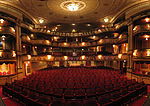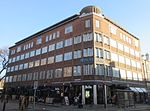Brighton Unitarian Church
AC with 0 elementsChurches completed in 1820Churches in Brighton and HoveGrade II listed buildings in Brighton and HoveGrade II listed churches in East Sussex ... and 2 more
Greek Revival church buildings in the United KingdomUnitarian chapels in England

The Brighton Unitarian Church, previously known as Christ Church, is a Unitarian chapel in Brighton, England. Built in 1820 by prolific local architect Amon Henry Wilds on land sold to the fledgling Unitarian community by the Prince Regent, the stuccoed Greek Revival building occupies a prominent position near the corner of Church Road and New Road in the centre of Brighton, near the Royal Pavilion and the city's main theatres. It has had Grade II listed status since 1952. It is a member of the General Assembly of Unitarian and Free Christian Churches, the umbrella organisation for British Unitarians.
Excerpt from the Wikipedia article Brighton Unitarian Church (License: CC BY-SA 3.0, Authors, Images).Brighton Unitarian Church
New Road, Brighton Round Hill
Geographical coordinates (GPS) Address External links Nearby Places Show on map
Geographical coordinates (GPS)
| Latitude | Longitude |
|---|---|
| N 50.823888888889 ° | E -0.13944444444444 ° |
Address
Brighton Unitarian Church
New Road
BN1 1UF Brighton, Round Hill
England, United Kingdom
Open on Google Maps











